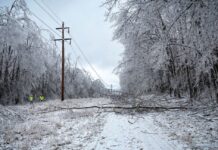Extreme sports are big in Michigan and across the nation.

When Chris Schmidt puts on his helmet on Oct. 20, the 44-year-old technical translator and bike racer will have only one thing in mind: going fast and all-out. Schmidt will be one of 50 competitors at the two-day Keweenaw Cup in Copper Harbor, which is part of the UPCROSS race series culminating with the U.P. Cyclocross Championships in Marquette in December.
Schmidt is a Class A racer, an expert in a sport thought to originate in the early 1900s in France. He and other competitors will race to see who “has the stuff”—the ability to ride fastest over undulating grassy and dirt terrain, weaving in and out of the trees while negotiating barriers along the route.
“On a road-bike race, you may spend quite bit of time taking it easy for a half-hour of pain and suffering,” says Schmidt, a competitive cyclist since high school. “But in cyclocross racing, you are in pain all the time. You are going all-out.”
Schmidt lives in Houghton with his wife, Rhiannon, and their 3-year-old daughter. He pushes himself for the fun of it and enjoys the opportunity to get out and ride with friends, the 14 other members of the Red Jacket Cycling Team. The team is a group of Houghton area cyclists who compete in a variety of endurance events from 12- and 24-hour mountain bike races to a 160-mile gravel road race.
“Cyclocross racing is one of the hardest things I’ve ever done in bike racing, but the nice thing is it’s over pretty quickly,” adds James Bialas, of Pelkie, a member of the Ontonagon County REA electric co-op, and another of the Red Jacket Cycling Team.
“You go out and suffer for a half-hour or 45 minutes and then it’s done and you go and cheer your friends,” Bialas says.
That thrill of competition and a love for physical challenge, sometimes even a bit of the absurd, has fueled the growing popularity of cycling and adventure and extreme races around the U.S. and Michigan.
There are 19 events on the fall calendar in Michigan. Some are lengthy endurance races running 12 to 30 hours. They require competitors to run, paddle and bike while navigating in the woods with a map and compass. Others are shorter but more extreme, like the “Xtreme Muck Ruck” (extrememuckruck.com) that debuts Sept. 8 in Copemish. Chest-deep mud and large boulders are among the obstacles that runners confront. The 5K race course was designed for big, mud-running trucks.
“Runners face 26 different obstacles,” explains Paul Derby, the Muck Ruck coordinator. “They crawl, climb, swing, balance on tippy-toes, and jump to get over things. When runners cross the finish line they are covered from head to toe with mud and dirty water, but with smiles on their faces.
“This form of racing has been around in the U.S. for close to six to seven years, but it’s grown in the last two or three, drawing huge crowds of fans and spectators.”
Running, jogging and trail running are followed by bicycling and triathlons as the top three favorite outdoor activities for American adults according to a 2012 study by the Outdoor Industry Association. Adventure racing grew by 16 percent between 2008 and 2011, and over 1 million Americans participated in 2011.
Derby expects 500 to 700 people at the Muck Ruck event. He got interested in this sort of racing after participating in the Warrior Dash (warriordash.com), an extreme event that first came to Michigan in 2010. The Warrior Dash is now staged in over 36 states, each drawing thousands of spectators and participants. The competitors run through mud and fire and deal with challenging obstacles.
“I am not one to run the entire course. I run and jog and even cry a little,” Derby says. “Adventure racing is typically running, swimming, kayaking and bicycling. I haven’t done any of that. I am more of a mud racer.”
One of the more unusual races planned for this fall is the 5K Zombie Dash on Halloween weekend (Oct. 27) in downtown Grand Rapids (thezombiedash.com). Organized by Michigan Adventure Racing, it started last spring in a commercial orchard just outside of town.
“We had 600 runners and 200 zombies waiting in the trees. It’s like a haunted house format,” says Mark VanTongeren, of Ada, co-owner of Michigan Adventure Racing.
VanTongeren’s company is holding 11 races this year, including the Grand Rapids Urban Adventure Race, which drew 750 people in its first year. The turnout far exceeded VanTongeren’s expectations.
“It was a hit,” he says. “There was nothing quite like it out there. We knew we had something good, and I left my corporate job to put these events on full-time.”
VanTongeren is personally an adventure race purist. Having participated in many over the years, he prefers the longer, more traditional race format that stresses orienteering, mountain biking, canoeing and trail running. “You have to pace yourself to get through the night. What I like about it is the challenge of finding certain points in the woods. It’s like an adult Easter-egg hunt,” VanTongeren says.
The pinnacle of Michigan adventure races can take 15 to 30 hours to complete. They aren’t as popular as the six to 10-hour variety, according to Zac Chisholm, of Manistee, the race director for Infiterra Sports. His company organizes a variety of challenging races, including the 10th annual 28-Hour Adventure Rage (infiterrasports.com) set for Sept. 7-9 in Cadillac. Participants will test their endurance and skills using map and compass, walking and running, canoeing, biking and climbing fixed ropes.
“This kind of adventure racing is not a popular mass spectator event,” Chisholm adds. “We typically get more males than females and they are usually 30 to 40 years old. But it draws people from urban and rural backgrounds, typically all people who like to go out in the woods and have fun.”





